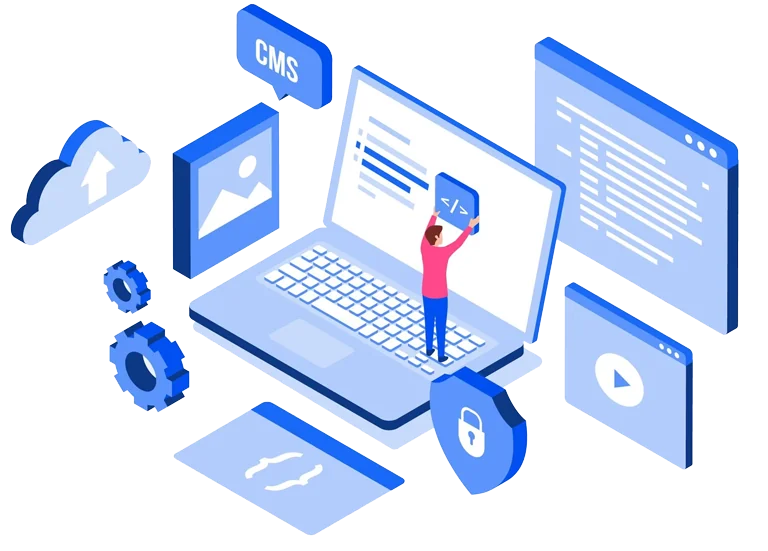The world of web application development is evolving rapidly, and 2025 promises to be no exception. As technology advances, businesses must stay ahead of the curve to meet consumer demands and provide the best user experiences. Whether you’re a developer, entrepreneur, or simply someone with a keen interest in the future of web applications, understanding the top web app development trends is crucial to staying competitive.
This blog will explore the five key trends dominating the web app development landscape 2025 and beyond.
5+ Web App Development Trends of 2025
1. AI-Powered Web Applications
Artificial Intelligence (AI) is not just a buzzword but a transformative force in web application development. In 2025, AI-powered web applications will be universal, offering businesses the potential for smarter, more personalized user experiences. From AI-powered chatbots to personalized content recommendations, the possibilities are endless. By integrating AI, web apps can automate routine tasks, provide intelligent recommendations, and enhance customer support through chatbots and virtual assistants. The ability of AI to process vast amounts of data quickly allows developers to create applications that adapt in real-time, promising a future of more intuitive, smarter applications.
For instance, in e-commerce, AI can predict user preferences, personalize shopping experiences, and optimize inventory management. In healthcare, AI can assist in diagnostic tools, treatment recommendations, and patient care. The possibilities are endless, and AI will be the driving force behind more intuitive, smarter applications, ultimately enhancing user experiences and business efficiency.
2. Utility-First CSS Frameworks
In 2025, web developers will increasingly adopt utility-first CSS frameworks like Tailwind CSSare, which are gaining popularity due to their flexibility and efficiency in the design process. These frameworks allow developers to apply styling directly in the HTML rather than writing separate CSS files. This approach minimizes code redundancy and speeds up the development process.
Utility-first frameworks are also more flexible and customizable. They give developers complete control over the design of web apps without requiring them to write custom CSS for each element. This approach is especially beneficial for projects requiring responsive designs, as developers can quickly adjust layouts and elements based on the user’s device and screen size. In addition, utility-first frameworks offer better collaboration between designers and developers, as the design logic is embedded directly into the code.
3. Progressive Web Apps
Progressive Web Apps (PWAs) have been around for a few years, but their adoption is set to soar in 2025. PWAs offer the best of both worlds: the user experience of a native mobile app combined with the accessibility of a website. PWAs work offline, load instantly, and are highly reliable, even on slow networks. These web apps are designed to be responsive, meaning they adapt to any screen size, whether a phone, tablet, or desktop.
PWAs eliminate the need for users to download an app from an app store, making them more accessible and easier to maintain. Businesses benefit from reduced development costs, as a single PWA can serve both web and mobile users and provide consistent performance across platforms. As mobile usage continues to rise, PWAs are set to be the go-to solution for delivering seamless cross-platform experiences.
4. No-Code Development
No-code development platforms are not just a trend, but a revolution in the making. By 2025, tools like Bubble, Webflow, and Adalo will be even more influential in web app development. These platforms, with their visual interfaces and drag-and-drop features, empower users with little coding experience to design, develop, and deploy fully functional web apps. The rise of no-code tools democratizes web development, enabling entrepreneurs, small businesses, and non-technical teams to create and launch their applications quickly, putting the power of development in the hands of the many.
No-code development is beneficial for rapid prototyping and creating MVPs (Minimum Viable Products). It allows businesses to test ideas, validate concepts, and make quick adjustments without investing heavily in development resources. While no-code platforms may not be suitable for highly complex or custom applications, they are ideal for building simple, scalable web apps.
5. Increased Significance of Cyber Security
As cyber threats continue to evolve, ensuring the security of web applications will be more critical than ever in 2025. As more businesses move their operations online and handle sensitive customer data, developers must implement robust security protocols to protect against data breaches, hacking attempts, and other cyber risks.
Web app security will focus on encryption, multi-factor authentication, secure APIs, and frequent security audits. Implementing AI and machine learning in security systems will also enhance threat detection and response times. As privacy regulations become stricter globally, businesses must guarantee compliance with data protection laws such as GDPR and CCPA.
6. Rapid Loading Speeds
In an era of instant gratification, slow-loading websites are a significant turn-off for users. In 2025, optimizing web app performance for faster loading speeds will be a top priority for developers. Users are more likely to abandon a website if it takes more than a few seconds to load. As a result, businesses will focus on reducing load times through techniques such as code minification, lazy loading, and image compression.
Additionally, the growing popularity of serverless architectures and Content Delivery Networks (CDNs) will help improve web app performance by reducing server load and speeding up content delivery. As web apps become more complex, developers must adopt best practices for maintaining performance without sacrificing functionality.
7. The Adoption of 5G Technology
The rollout of 5G networks is expected to revolutionize web application use. With faster internet speeds and lower latency, 5G technology will enable developers to create more sophisticated, real-time web apps with improved performance and responsiveness. For instance, web apps that require high-bandwidth data, such as gaming, video streaming, and augmented reality (AR) applications, will benefit significantly from 5G’s capabilities.
In addition to faster speeds, 5G will open up new possibilities for the Internet of Things (IoT) and smart cities, where web apps will be used to monitor and manage connected devices. Developers will need to optimize their web apps for 5G, ensuring they can take full advantage of the increased bandwidth and lower latency.

How to Choose A Web App Development Agency in 2025?
Choosing the right development agency is more critical than ever as the web app development landscape evolves. Here are some factors to consider when selecting a web app development partner in 2025:
- Expertise and Experience: Ensure the agency knows the latest web app development trends, such as AI integration, PWA development, and cybersecurity practices. Look for agencies with a proven track record of delivering high-quality applications.
- Portfolio and Case Studies: Review the agency’s portfolio to assess the quality of its previous projects. Case studies provide insight into the agency’s problem-solving abilities and how it handles complex challenges.
- Agile Development Process: Agility is essential in 2025. Choose an agency that follows agile development methodologies, allowing flexibility, faster iterations, and a collaborative approach to development.
- Security Standards: Given the increasing importance of cybersecurity, ensure that the agency follows best practices for securing web applications. Ask about their approach to data protection, secure coding, and compliance with global privacy regulations.
- Post-Launch Support: Web app development doesn’t end at launch. Opt for an agency that offers ongoing maintenance and support to address bugs, implement updates, and scale your application as needed.
Final Thoughts
To summarize, adopting latest technologies such as AI, 5G, and no-code development will define web app development in 2025. The need for faster, more secure, and more user-friendly applications will push developers to innovate and adapt to these emerging trends. As businesses look to enhance their digital presence, staying up-to-date with these trends will be key to remaining competitive and meeting user expectations.













